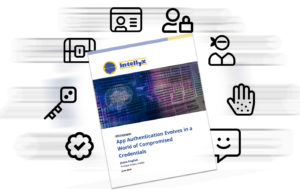 Intellyx Whitepaper for Acceptto by Jason English
Intellyx Whitepaper for Acceptto by Jason English
Are we intelligently identifying persistent threats, without falling behind on customer needs?
Who goes there? Before recorded history, humans practiced authentication. Whether through facial recognition, names, secret knocks and handshakes or even body language, the ability to distinguish between friend and foe, or fair trader versus fraudster, is a likely reason why our ancestors survived.
Authentication is the process of determining who should and shouldn’t be authorized to enter or stay within a given location. Or in software terms, who has credentials to use a given application. While authentication has evolved a long way since it was a life-or-death matter, in some ways it is still just as vital to our interests today.
Unfortunately, by the time you read this paper, you can assume that every person or company you know has likely had aspects of their identity or credentials exposed or hacked.
Security measures don’t work when users themselves are becoming the vulnerability and failing to protect their own access point to critical systems.
Take for instance the Marcher attack, a fast-evolving Trojan malware that continues to embed itself on possibly more than 60,000 Android phones through game downloads, updates and email phishing scams since 2013, employing bots to compromise users’ banking and credit card information. Users voluntarily downloaded Marcher, so ‘keeping the bad guys out’ failed.
This paper discusses the evolution of authentication, and modern techniques for staying ahead of growing risks while continuously improving customer experience.
Download the full Intellyx whitepaper on the Acceptto site here: https://info.acceptto.com/intellyx



